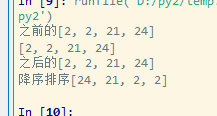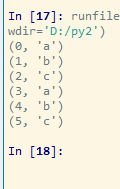#all()函数用于判断给定的可迭代参数iterable 中所有元素是否都为true,(除了是0、false、空都为true)
#空元组、空列表都为true.
#序列操作 str、元组、list
print(all([])) #true
print(all(())) #true
print(all[1,2,0])#false
#any() 函数用于判断给定的可迭代参数,是否全部为false.(如果有一个为true,则返回true)
print(any([1,0,False,2])) #true
#sorted() 对所有可迭代的对象进行排序。
#sort是应用在list上的方法,sorted可以对所有可迭代进行排序;
#sort返回的是已经存在的列表,而sorted是返回一个新的列表。
li=[2,24,2,21]
li.sort()
print('之前的{}'.format(li))
print(sorted(li))
varList=sorted(li) #它不会修改原来的,所以最好要用一个变量来赋值。
print('之后的{}'.format(varList))
varList=sorted(li,reverse=True)
print('降序排序{}'.format(varList))

#range() 创建一个整数列表,一般用在for循环中。
#range(start,stop[,step])
#zip()就是用来打包的。会吧序列中对应的索引位置的元素存储为一个元组来进行输出。
s1=['a','b','c']
s2=['你','我','他','她']
print(list(zip(s1))) #压缩一个数据
zipList=zip(s1,s2)
print(list(zipList)) #压缩两个数据
例子:图书管理的一个小例子。
def printBook():
books=[] #存储所有图书信息
id=input('请输入编号:每项以空格分隔')
bookName=input('请输入书名')
bookPos=input('请输入位置')
idList=id.split(' ')
nameList=bookName.split(' ')
posList=bookPos.split(' ')
bookInfo=zip(idList,nameList,posList)
for bookItem in bookInfo:
'''图书存储信息 '''
dictInfo={'编号':bookItem[0],'书名':bookItem[1],'位置':bookItem[2]}
books.append(dictInfo)
pass
for item in books:
print(item)
pass
printBook()

**#enumerate()**函数用于将一个可遍历的数据对象组合成一个索引序列,同时列出数据和1数据下标,一般在for循环中。
listOBJ=['a','b','c']
for item in enumerate(listOBJ):
print(item)
listOB1=['a','b','c']
for item in enumerate(listOBJ,3):
print(item)

它还可以用来遍历字典






















 104
104











 被折叠的 条评论
为什么被折叠?
被折叠的 条评论
为什么被折叠?








